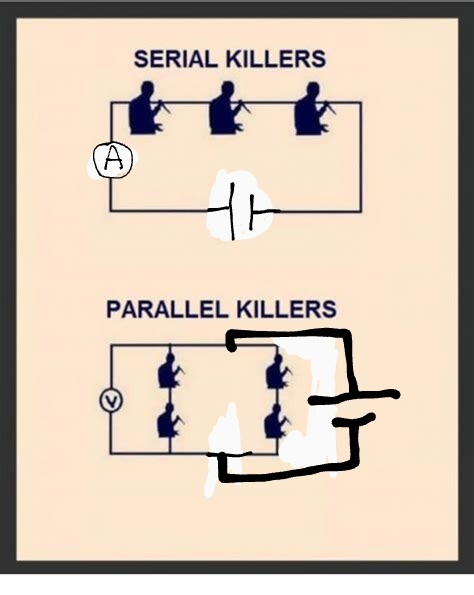deleted by creator
Aren’t the parallel killers technically two serial killers in parallel though?
Nah, none of the killers or pairs of killers are in parallel cuz there’s a resistor in the way
the capacity would be the same. the runtime is just lower because you draw more power
if you draw the same wattage (NOT amperage)from a 3Series or 3Paralell pack, it will last for the same time
deleted by creator
I felt crazy for a second, but you both have it backwards. Running 2 batteries in series means doubling power, (12 v + 12v = 24v power) but same amp/hour as a single 12v. running the same 2 batteries in parallel means 12v of power, but double the amp/hr.
Source: Am an electrician with shit memory, google confirmed it.
Volts don’t measure power. Also nobody specified the load was resistive. Most loads are not resistive. See light bulbs, diodes (inc. LEDs) and even electric motors as an example. If you are talking about resistive loads you need to specify that. For a resistive load doubling the potential difference (volts) causes the current to also double because I = V / R and power to quadruple P = VI. So run time would half since you are spending double the energy at four times the power (power is rate of energy consumption).
I am now disappointed in people who call themselves electricians.
Similarly, batteries, for an example, wired in parallel will give you more power for less capacity, while batteries wired in series gives you more capacity but less power.
You have no idea how batteries or electronics work. Adding in parallel increases capacity and maximum current and maximum power. Adding in series increases emf (volts) and maximum power and capacity. Adding extra batteries almost always increases capacity in some way. The actual duration is as much about load as capacity.
If your load is something like a resistor then adding batteries in parallel will increase duration since current draw and power output stay the same and capacity has doubled.
If your wire in series then current draw will double and power draw will quadruple because the potential difference (volts) has doubled. This follows I = V / R and P = VI. This also means the duration is halved because the power drain is 4x but the capacity is only 2x. Make sense?
I = Current
V= Potential difference (p.d) / electromotive force (e.m.f) measured in volts
R = load resistance
If something supplies power you call it’s voltage electromotive force, if it uses power then it’s called potential difference. Why is it this way? No idea
Please note I am not factoring in internal resistance and some other factors here because that makes things way more complicated.
Also you can measure battery capacity in two ways: amp hours and watt hours. Only one actually tells you the total energy stored, which is watt hours. To work out watt hours from amp hours you need to multiply it by the nominal imf (volts) of the battery.
What is attention an analogy for?
I see 196 is going through its electrical phase. Most of the time, there are three.
The Ⓥ symbol represents a voltmeter rather than a power source so virtually no current will flow in the first circuit.
In the second circuit, the right pair of hitmen is shorted so the voltage across them is zero while the current through the rightmost path can be very high. It can be simplified into two circuits: a. one with 2 shorted hitmen, b. one with one series pair of hitmen in parallel to a “resistor” and voltmeter.
Assuming the two hitmen are committing to a battery, the “b” circuit actually makes sense.fixed






